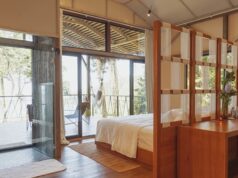 NEW YORK—Hampton Inn Elmira Horseheads (N.Y.), part of the global brand Hampton Hotels, announced that the hotel achieved LEED Silver certification, as recognized by the U.S. Green Building Council (USGBC), the internationally recognized green building certification, which provides third-party verification that a building was designed and operated to provide enhanced energy savings, water efficiency, emissions reduction and overall environmental quality.
NEW YORK—Hampton Inn Elmira Horseheads (N.Y.), part of the global brand Hampton Hotels, announced that the hotel achieved LEED Silver certification, as recognized by the U.S. Green Building Council (USGBC), the internationally recognized green building certification, which provides third-party verification that a building was designed and operated to provide enhanced energy savings, water efficiency, emissions reduction and overall environmental quality.
“This is a great achievement for the Hampton Inn Elmira Horseheads,” said Rick Fedrizzi, president, CEO and founding chair, U.S. Green Building Council. “A LEED silver certification demonstrates tremendous green building leadership by ownership and management.”
“This is a wonderful accomplishment for our hotel, and we are proud to add the Hampton Inn Elmira’s LEED Silver certification to our Hampton family achievements,” said David Lubin, managing partner. “This achievement emphasizes our commitment to sustainability, our community and drives us to invest in and operate our hotels efficiently. It also demonstrates that developing a healthier more efficient building isn’t just for museums and sophisticated office buildings and hotels but can be incorporated into buildings of everyday design.”
Hotel Developers: David Lubin & Tom Milnes
The Hampton Inn Elmira Horseheads was developed by David Lubin and Tom Milnes. The Milnes Co. managed the construction and Angie Plantz, LEED AP in their offices, oversaw the LEED certification process.
The property is managed by Sustainable Development Management which is led by president, Brendalyn Keefer and Hampton Inn general manager, Brenda Curren.
 The Hampton Inn Elmira Horseheads received its LEED Silver certification on November 18, 2011. The hotel incorporated a variety of sustainable design strategies to achieve the certification, including categories in energy use, lighting, water and material use. LEED certified buildings save money and energy, decrease CO2 emissions, improve water efficiency and indoor environmental quality for hotel guests, employees and the community.
The Hampton Inn Elmira Horseheads received its LEED Silver certification on November 18, 2011. The hotel incorporated a variety of sustainable design strategies to achieve the certification, including categories in energy use, lighting, water and material use. LEED certified buildings save money and energy, decrease CO2 emissions, improve water efficiency and indoor environmental quality for hotel guests, employees and the community.
In the area of design and construction the following environmentally friendly choices were made:
• Insulated concrete forms (ICF) were used for the structure of the building. The unique combination of continuous insulation, airtight construction and the thermal mass of insulating concrete form construction contributes significantly to energy savings.
• The centerpiece of the heating and cooling system for the hotel is geothermal (ground source) heat pumps. A vertical closed loop system allows liquid to be circulated to the ground and back while heat pumps extract what the thermostat requires, either warming or cooling the structure.
• Zero CFC-based refrigerants were used in the air-conditioning systems.
• Low emitting (VOC) materials including glues, sealants and paints were used during the construction.
• The landscaping design utilized native plants and eliminated the need for an irrigation system.
• The construction teams utilized separate dumpsters for metal, paper, wood and plastic during the construction process to greatly reduce the project’s use of landfills.
In the area of operating systems:
• The hotel’s efficient insulation system, glazing, white roof, hot water production, geothermal air-conditioning and heating and energy efficient lighting equipment allows the Hampton Inn to reduce its annual energy usage by 39.5 percent and as a result reaps an operating cost reduction of 46.1 percent compared to a hotel built to standard building code.
• Water saving fixtures reduce water usage by more than 33 percent.
• The ozone laundry system greatly reduces the environmental impact of traditional laundry operations by reducing water usage, energy usage and eliminating some environmentally unfriendly chemicals.
• The carpet system which was installed using carpet squares controls wear and reduces replacement materials and expense. The carpet is made of recycled materials and can be recycled again.
• The property purchased renewable energy certificates for 100 percent of the building’s energy usage to reduce its carbon footprint and maximize the hotel’s sustainability. This purchase money supports the development of renewable energy including solar, wind and geothermal projects.
Click here for more information.






